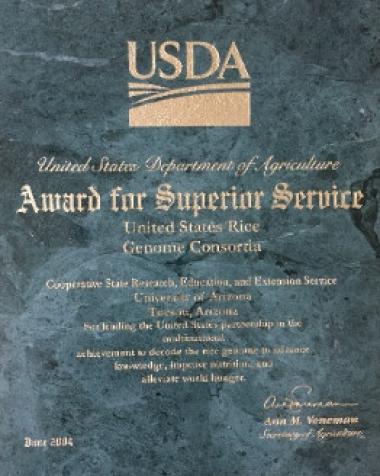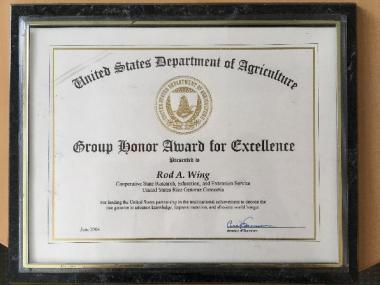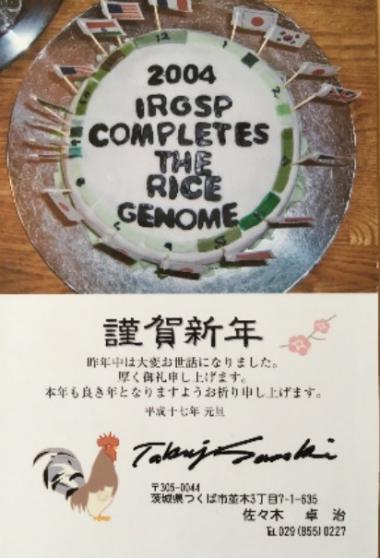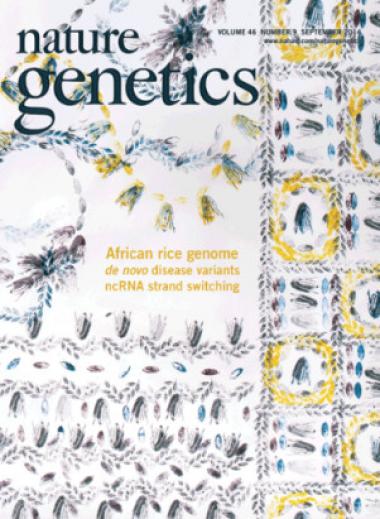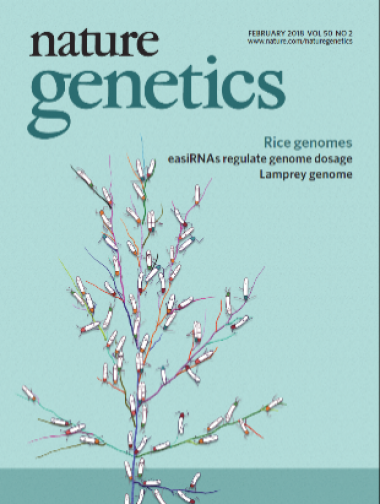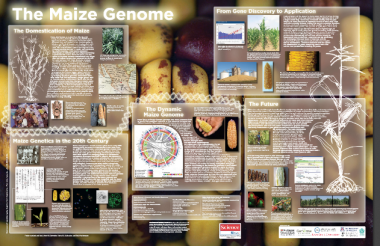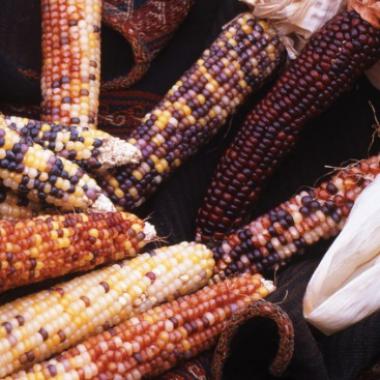Major Accomplishments
In the summer of 2002 Professor Wing moved to the University of Arizona as a full professor in the School of Plant Sciences to found the Arizona Genomics Institute (AGI) which has played significant roles in over 75 plant and animal genome projects. AGI has been a PI/Co-PI on over $135M of grant funding ~$68M going directly to UA. In 2005 Professor Wing became the first holder of the Bud Antle Endowed Chairs for Excellence in Agriculture and Life Sciences.
The Wing lab’s most significant contributions to science has revolved around the International Oryza Map Alignment Project (IOMAP). IOMAP is a biology project that was created out of our work to sequence the rice genome. Rice is the most important food crop in the world and with a 2.6 billion increase in our population by 2050 we must do all we can to develop new varieties of crops that are higher yielding and more nutritious, while at the same time have less of an environmental footprint. My approach to helping to solve the 10-billion people question is to identify, understand and harness the majority of natural variation that is already present in cultivated rice and its wild ancestors, and use that information to create the next generation of green super crops. In rice we call these “green super rice” varieties.
The Wing lab’s most significant contributions along this theme can be found in the following 8 publications.
1) The International Rice Genome Sequencing Project (Lead authors listed as Principal Investigators: T. Sasaki, R. Buell, B. Han, F. Quetier, R.A. Wing, W.R. McCombie, Y.I. Hsing, A.K. Tyagi, N.K. Singh, J. Messing, J.H. Hahn, A. Vanavichit, A.C. Oliveria) . 2005. The map based sequence of the rice genome. Nature [Article] 436:793-800.
This paper described the first gold standard reference genome for any crop plant and remained the highest quality crop genome available until 2016. In 2005, the USA teams were awarded the “USDA Secretary’s Honor Award” in Washington DC by Secretary Ann Veneman with R.A. Wing as the “Team Leader”. This is the highest honor a team can receive from the USDA.
2) Piegu, B., R. Guyot, N. Picault, A. Roulin, A. Saniyal, H. Kim, K. Collura, D.S. Brar, S. Jackson, R.A. Wing, & O. Panaud. 2006. Doubling genome size without polyploidization: dynamics of retrotransposition-driven genomic expansions in Oryza australiensis, a wild relative of rice. Genome Res 16:1262-1269.
This was the first significant paper that came out of our IOMAP work and demonstrated for the first time how a genome could more than double in size without undergoing polyplodization. This was a collaboration with Olivier Panaud’s group in France.
3) Ammiraju, JSS, F. Lu, A. Sanyal, Y. Yu, X. Song, N. Jiang, A.C. Pontaroli, T. Rambo, J. Currie, K. Collura, J. Talag, C. Fan, J.L. Goicoechea, A. Zuccolo, J. Chen, J.L. Bennetzen, M. Chen, S. Jackson, and R.A. Wing. 2008. Dynamic evolution of Oryza genomes is revealed by comparative genomic analysis of a genus-wide vertical data set. Plant Cell 20:3191-3209.
This was the first single-locus multi-genome (10) comparative analysis using finished BAC clones bridging 15MY of evolutionary history.
4) Fan, C., J. Walling, J. Zhang, J. Jiang, & R.A. Wing. 2011. Conservation and purifying selection of transcribed genes in recombination-free centromeres. Plant Cell 8:2821-2830.
This paper used a set of finished BAC clones to explore selection in and around rice centromeres.
5) Wang, M., Y. Yu, G. Haberer, P. Marri, C. Fan, J.L. Goicoechea, A. Zuccolo, X. Song, D. Kudrna, S.A. Jetty, R. Cossu , C. Maldonado, J. Chen , S. Lee, N. Sisneros, K. de Baynast , W. Golser, M. Wissotski, W. Kim , P. Sanchez, M.N. Ndjiondjop, K. Sanni , M. Long, J. Carney, O. Panaud, T. Wicker, C. Machado, M. Chen, K. Mayer, S. Rounsley, & R.A. Wing. 2014. The genome of African rice (Oryza glaberrima): Evidence for independent domestication. Nature Genetics [Article, Cover and News & Views piece by M. Purugganan] 46:982-988.
This is was first publication of a high-quality genome assembly for African rice. African rice was domesticated independently of Asian rice 7,000 apart. The Wing lab showed that the same genes that control shattering in both species, but different mutations, were independently selected for during the domestication process.
6) J.C. Stein, Y. Yu, D. Copetti, D.J. Zwick, L. Zhang, C. Zhang, K. Chougule, D. Gao, A. Iwata, J.L. Goicoechea, S. Wei, J. Wang, Y. Liao, M. Wang, J. Jacquemin, C. Becker, D. Kudrna, J. Zhang, C.E.M. Londono, X. Song, S. Lee, P. Sanchez, A. Zuccolo, J.S.S. Amiraju, J. Talag, A. Danowitz, L.F. Rivera, A.R. Gschwend, C. Noutsos, C. Wu, S. Kao, J. Zeng, F. Wei, Q. Zhao, Q. Feng, M. Elbaidouri, M.C. Carpentier, E. Lasserre, R. Cooke, D.R. Farias, L.C. Maia, R.S. Santos, K.G. Nyberg, C. Fan, D. Weigel, K.K. Jena, T. Wicker, M. Chen, B. Han, R. Henry, Y.C. Hsing, N. Kurata, A.C. Oliveira, O. Panaud, S.A. Jackson, C.A. Machado, M.J. Sanderson, M. Long, D. Ware & R.A. Wing. 2018. Genomes of 13 domesticated and wild rice relatives reveal genetic conservation, turnover and innovation across the genus Oryza. 2018. Nature Genetics [Article & Cover] 50:285-296.
This paper describes the generation of 7 new high-quality Oryza genomes and the detailed comparative evolutionary analysis of these 7 with 6 other published Oryza genomes that span a 15MY time frame. This work identified over 4500 putative disease resistance gene that are structurally enriched in a head-to-hear configuration which strongly supports the “integrated decoy” model of disease resistance in plant.
7) Wang, W., R. Mauleon, Z. Hu, D. Chebotarov, S. Tai, Z. Wu, M. Li, T. Zheng, R.R. Fuentes, F. Zhang, L. Mansueto, D. Copetti, M. Sanciangco, K.C. Palis, J. Xu, C. Sun, H. Zhang, B. Fu, Y. Gao, X. Zhao, F. Shen, X. Cui, H. Yu, Z. Li, M. Chen, J. Detras, Y. Zhou, X. Zhang, Y. Zhao, D. Kudrna, C. Wang, R. Li, B. Jia, J. Lu, X. He, Z. Dong, J. Xu, Y. Li, M. Wang, J. Shi, J. Li, D. Zhang, S. Lee, W. Hu, A. Poliakov, I. Dubchak, V.J. Ulat, F.N. Borja, J.R. Mendoza, J. Ali, J. Li, M. Yang, Y. Niu, Z. Yue4, M.E.B. Naredo, J. Talag, X. Wang, J. Li, X. Fang, Y. Yin, J.C. Glaszmann, J. Zhang, J. Li, R.S. Hamilton, R.A.Wing*, C. Wei*, J. Ruan*, G. Zhang*, K.L. McNally*, N. Alexandrov*, Z. Li*, H. Leung (*Co-corresponding authors). 2018. Harnessing natural variation across 3,000 rice genomes: SNP discovery, population structure and genome diversity. 2018. Nature [Article] 557:43-49.
This paper described a detailed analysis SNPs and structural variants when mapping 3000 resequenced rice accessions to a single reference genome. Using these data we were able to subdivide the 3000 accessions into 9 distinct subpopulations.
This paper opens the door to the establishment of a global rice array whereby all 3000 accessions will be extensively phenotyped across the globe, including Maricopa, under different environmental conditions. Such data linked with SNP/SV data will permit the rapid association of traits to genomic positions, thereby accelerating the breeding of new green super rice varieties that are locally adapted to specific environmental pressures.
8) Wing, R.A, M.D. Purugganan & Q. Zhang. The rice genome revolution: from an ancient grain to Green Super Rice. 2018. Nature Reviews Genetics [Article & Cover] 19:505-517.
This review, describes the long range vision of utilizing genomics, evolution and natural variation to breed the next generation of green super crops to help solve the 10 billion people question.
Finally, the most significant non-rice genome project that AGI led was that of maize. This project was a $30M NSF Plant Genome Project led by the Washington University Genome Sequencing Center and AGI. The Wing lab built the BAC libraries and physical map, selected the minimum tiling path across the entire genome, prepared and validated all 18,000 sequencing substrates, finished 25% of the BAC assemblies, assembled the genome and performed a detailed analysis on the structure of the maize genome. This was the first reference quality genome of a crop plant with a genome size near that of the human genome.
1) Schnable, P.S., D. Ware, R.S. Fulton, J.C. Stein, F. Wei, S. Pasternak, C. Liang, J. Zhang, J. Fulton, L. Graves, T.A., P. Minx, A.D. Reily, L. Courtney, S.S. Kruchowski, C. Tomlinson, C. Strong, K. Delehaunty, C. Fronick, B. Courtney, S.M. Rock, E. Belter, F. Du, K. Kim, R.M. Abbott, M. Cotton, A. Levy, P. Marchetto, K. Ochoa, S. M. Jackson, B. Gillam, W. Chen, L. Yan, J. Higginbotham, M. Cardenas, J. Waligorski, E. Applebaum, L. Phelps, J. Falcone, K. Kanchi, T. Thane, A. Scimone, N. Thane, J. Henke, T. Wang, J. Ruppert, N. Shah, K. Rotter, J. Hodges, E. Ingenthron, M. Cordes, S. Kohlberg, J. Sgro, B. Delgado, K. Mead, A. Chinwalla, S. Leonard, K. Crouse, K. Collura, D. Kudrna, J. Currie, R. He, A. Angelova, S. Rajasekar, T. Mueller, R. Lomeli, G. Scara, A. Ko, K. Delaney, M. Wissotski, G. Lopez, D. Campos, M. Braidotti, E. Ashley, W. Golser, H.R. Kim, S. Lee, J. Lin, Z. Dujmic, W. Kim, J. Talag, A. Zuccolo, C. Fan, A. Sebastian, M. Kramer, L. Spiegel, L. Nascimento, T. Zutavern, B. Miller, C. Ambroise, S. Muller, W. Spooner, A. Narechania, L. Ren, S. Wei, S. Kumari, B. Faga, M.J. Levy, L. McMahan, P. Van Buren, M.W. Vaughn, K. Ying, C.-T. Yeh, S.J. Emrich, Y. Jia, A. Kalyanaraman, A.-P. Hsia, W.B. Barbazuk, R.S. Baucom, T.P. Brutnell, N.C. Carpita, C. Chaparro, J. Chia, J.-M. Deragon, J.C. Estill, Y. Fu, J.A. Jeddeloh, Yujun Han, Hyeran Lee, P. Li, D.R. Lisch, S. Liu, Z. Liu, D.H. Nagel, M.C. McCann, P. SanMiguel, A.M. Myers, D. Nettleton, J. Nguyen, B.W. Penning, L. Ponnala, K.L. Schneider, D.C. Schwartz, A. Sharma, C. Soderlund, N.M. Springer, Q. Sun, H. Wang, M. Waterman, R. Westerman, T.K. Wolfgruber, L. Yang, Y. Yu, L. Zhang, S. Zhou,
Q. Zhu, J.L. Bennetzen, R.K. Dawe, J. Jiang, N. Jiang, G.G. Presting, S.R. Wessler, S. Aluru, R.A. Martienssen, S.W. Clifton, W.R. McCombie, R.A. Wing, R.K. Wilson. 2009. The B73 Maize Genome: Complexity, Diversity, and Dynamics. Science [Article, Cover, Poster & Perspective by C. Feuillet & K. Eversole] 326:1112-1115.
2) Wei, F., J. Zhang, S. Zhou, R. He, M. Schaeffer, K. Collura, D. Kudrna, B.P. Faga, M. Wissotski, M., Golser, W., S.M. Rock, T.A. Graves, R.S. Fulton, E. Coe, P.S. Schnable, D.C. Schwartz, D. Ware, S.W. Clifton, R.K. Wilson, R.A. Wing. 2009. The physical and genetic framework of the maize B73 genome. PLoS Genet 5: e1000715
This paper is part of the PLOS Genetics “2009 Maize Genome Collection” which contains 10 companion manuscripts built off the B73 Maize Genome published in Science. This collection features an Editorial entitled “10 Reason to be Tantalized by the B73 Maize Genome, by V. Walbot. AGI has two additional manuscripts contained within this collection.


